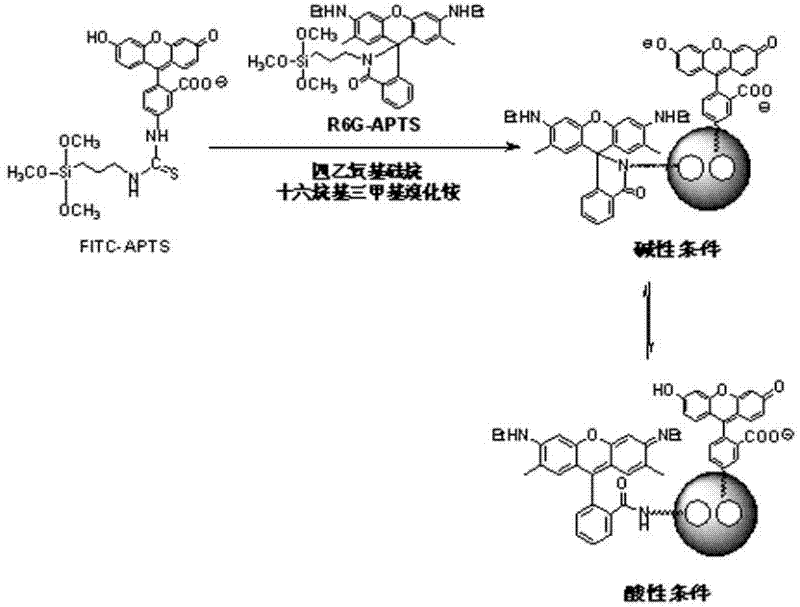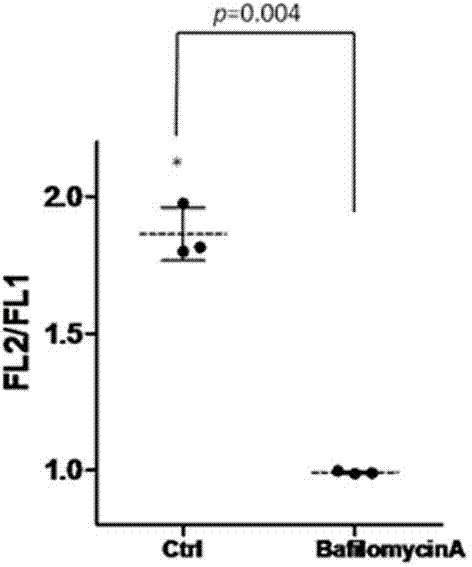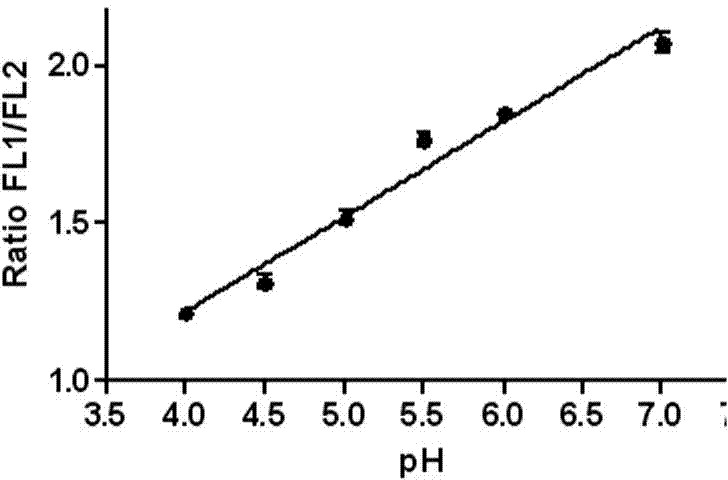Mesoporous silicon dioxide nano particle with bifluorescence mark
A mesoporous silica, nanoparticle technology, applied in the direction of nanotechnology, nanotechnology, nano-optics, etc. for sensing
- Summary
- Abstract
- Description
- Claims
- Application Information
AI Technical Summary
Problems solved by technology
Method used
Image
Examples
preparation example Construction
[0033] A mesoporous silica nanoparticle with double fluorescent labels, the preparation method comprising:
[0034] a) Vibrate and mix Rhodamine 6G and (3-aminopropyl)triethoxysilane at room temperature and avoid light until the fluorescence of Rhodamine 6G disappears to obtain R6G-APTS;
[0035] b) Fluorescein isothiocyanate and (3-aminopropyl)triethoxysilane were vibrated and mixed for 2 hours at room temperature in the dark to obtain FITC-APTS;
[0036] c) Mix R6G-APTS and FITC-APTS with ethyl orthosilicate, then add an appropriate amount of deionized water, cetyltrimethylammonium bromide and sodium hydroxide solution, and heat in a water bath at 80°C Vibrate for 2 hours and mix well; then centrifuge the solution to collect the precipitate; then treat the precipitate with ethanol containing 1% HCl and redissolve it by ultrasonication for 5 hours; the redissolved sample is redissolved by centrifugation and ultrasonication, and finally centrifuged Obtained mesoporous silica ...
Embodiment 1
[0038] Example 1: Synthesis of R6G-FITC-MSN
[0039] 1) Synthesis of R6G-APTS:
[0040] Add Rhodamine 6G (0.2 g) to 10 ml APTS[(3-aminopropyl)triethoxysilane] in a capped tube or bottle, shake and mix well at room temperature in the dark until Rhodamine 6G The fluorescence disappears, and R6G-APTS can be prepared;
[0041] 2) Synthesis of FITC-APTS:
[0042] FITC-APTS can be prepared by adding FITC (0.1 g) to 5 ml APTS in a capped tube or bottle, shaking and mixing for 2 hours at room temperature in the dark;
[0043] 3) Synthesis of R6G-FITC-MSN:
[0044] Mix 100 microliters of R6G-APTS and 100 microliters of FITC-APTS with 2.3 ml of TEOS (tetraethyl orthosilicate), then add 240 ml of deionized water, 0.5 g of CTAB (cetyltrimethylammonium bromide), 1.75ml of sodium hydroxide ( 2 M) in a clean Erlenmeyer flask, adjust the temperature of the Erlenmeyer flask to 80 degrees Celsius through a water bath, and shake at this temperature for 2 hours to mix, and then centri...
Embodiment 2
[0045] Example 2: Ratiometric pH titration of R6G-FITC-MSN under dual-wavelength light excitation
[0046] Sodium phosphate buffers with different pH gradients were used to prepare R6G-FITC-MSN into a solution with a final concentration of 1 μg / ml, and the excitation spectra of fluorescein excited at 488nm and rhodamine 6G lactam excited at 533nm corresponding to different pHs were measured. spectrum.
[0047] Such as figure 2 As shown in Figure C in the figure: the curve formed by connecting the hollow points in the figure is the acidity titration curve of the fluorescence emission intensity ratio of R6G-FITC-MSNs under dual-wavelength excitation (the excitation wavelength of FITC is 488nm, and the excitation wavelength of R6G-amide at 530 nm). The fluorescence excited by rhodamine 6G lactam increased with the decrease of pH at different pH, while the fluorescence of fluorescein excited by 488nm decreased with the decrease of pH. The fluorescence of the two responds dif...
PUM
| Property | Measurement | Unit |
|---|---|---|
| diameter | aaaaa | aaaaa |
Abstract
Description
Claims
Application Information
 Login to View More
Login to View More - R&D
- Intellectual Property
- Life Sciences
- Materials
- Tech Scout
- Unparalleled Data Quality
- Higher Quality Content
- 60% Fewer Hallucinations
Browse by: Latest US Patents, China's latest patents, Technical Efficacy Thesaurus, Application Domain, Technology Topic, Popular Technical Reports.
© 2025 PatSnap. All rights reserved.Legal|Privacy policy|Modern Slavery Act Transparency Statement|Sitemap|About US| Contact US: help@patsnap.com



